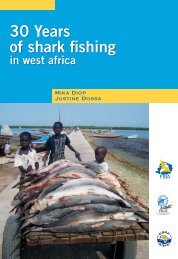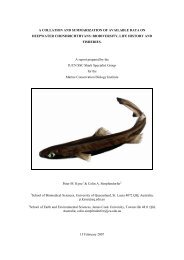Magazine of the species survival Commission specialist Group - IUCN
Magazine of the species survival Commission specialist Group - IUCN
Magazine of the species survival Commission specialist Group - IUCN
You also want an ePaper? Increase the reach of your titles
YUMPU automatically turns print PDFs into web optimized ePapers that Google loves.
<strong>specialist</strong> group exchange<br />
Jaragua purchased 20 hectares in DR<br />
encompassing a critically important<br />
nesting area for Ricord’s Iguana called<br />
Fonda de la Tierra near Pedernales.<br />
Over 140 hatched nests were<br />
documented in this area earlier this<br />
year. In Anse-a-Pitres, Haiti, where <strong>the</strong><br />
most fragile subpopulation <strong>of</strong> Ricord’s<br />
Iguana exists, <strong>the</strong> IIF and Grupo<br />
Jaragua recently conducted a<br />
workshop for local authorities with a<br />
proposal to create a Municipally<br />
Protected Habitat. If successful, this<br />
protected area would be <strong>the</strong> first <strong>of</strong> its<br />
kind in Haiti. The IIF, USFWS,<br />
MacArthur Foundation, Disney, and<br />
Sociedad Española de Ornitología<br />
support work on Ricord’s Iguana.<br />
In Fiji, two significant findings<br />
emerged from fieldwork conducted<br />
over <strong>the</strong> past year by <strong>the</strong> National Trust<br />
<strong>of</strong> Fiji, University <strong>of</strong> <strong>the</strong> South Pacific, Fiji<br />
Department <strong>of</strong> Environment, NatureFiji-<br />
MareqetiViti, Taronga Zoo, and <strong>the</strong> US<br />
Geological Survey. The first finding was<br />
<strong>the</strong> discovery <strong>of</strong> sizeable populations <strong>of</strong><br />
<strong>the</strong> newly described Fijian Banded<br />
Iguana (Brachylophus bulabula) on two<br />
government-owned islands, Mokogai<br />
and Makodrago. It is hoped that <strong>the</strong>se<br />
populations will serve as <strong>the</strong> focus <strong>of</strong> an<br />
assessment for a potential new national<br />
park within Fiji.<br />
The second finding was<br />
confirmation that Green Iguanas<br />
(Iguana iguana), illegally introduced to<br />
Fiji earlier this century, now occur on at<br />
least four islands with documented<br />
breeding on two islands. Green Iguanas<br />
are highly invasive, and juveniles are<br />
very similar in colour and shape to <strong>the</strong><br />
threatened endemic iguanas <strong>of</strong> Fiji, a<br />
similarity expected to hamper control<br />
efforts. Partial funding for fieldwork in<br />
Fiji came from CEPF and <strong>the</strong> IIF.<br />
Glenn Gerber and Miguel Garcia<br />
Co-Chairs, Iguana Specialist <strong>Group</strong><br />
With contributions from Ernst Rupp,<br />
Masani Accimé and Robert Fisher<br />
Invasive Species SG<br />
Supporting <strong>the</strong> development <strong>of</strong> a<br />
global Early Warning and Rapid<br />
Response framework for biological<br />
invasions<br />
The <strong>IUCN</strong> SSC Invasive Species<br />
Specialist <strong>Group</strong> (ISSG) is contributing to<br />
Red Palm Weevil (Rhynchophorus<br />
ferrugineus). © Riccardo Scalera<br />
<strong>the</strong> development <strong>of</strong> a global Early<br />
Warning and Rapid Response (EWRR)<br />
framework for biological invasions, by<br />
supporting <strong>the</strong> improvement,<br />
harmonization and integration <strong>of</strong> related<br />
information systems (e.g. to develop<br />
alarm listing systems, diagnosis <strong>of</strong><br />
invaders, a web-based global register <strong>of</strong><br />
invasive <strong>species</strong>, access to updated and<br />
detailed management information, etc.).<br />
The group has been participating in<br />
several relevant international<br />
conferences and workshops, both to<br />
provide advice and contribute to <strong>the</strong><br />
development <strong>of</strong> regional and national<br />
EWRR systems, particularly in Europe.<br />
Networking activities, with countries and<br />
regions where early warning systems are<br />
already being implemented, are ongoing.<br />
In 2009, a major ISSG achievement<br />
was <strong>the</strong> publication <strong>of</strong> Towards an early<br />
warning and information system for<br />
invasive alien <strong>species</strong> (IAS) threatening<br />
biodiversity in Europe, produced under<br />
contract with <strong>the</strong> European<br />
Environment Agency. The report was<br />
prepared by a team <strong>of</strong> experts, led by<br />
<strong>the</strong> Institute for Environmental Research<br />
and Protection (ISPRA) Italy, in<br />
collaboration with <strong>the</strong> ISSG. It<br />
contributes to <strong>the</strong> ongoing development<br />
<strong>of</strong> an EU Strategy on invasive alien<br />
<strong>species</strong>, which <strong>the</strong> European<br />
<strong>Commission</strong> committed to complete in<br />
2011. An abridged version <strong>of</strong> <strong>the</strong> report<br />
is available online here.<br />
In 2009/2010, <strong>the</strong> ISSG launched its<br />
re-designed website (www.issg.org)<br />
and newsletter. Both will contribute to<br />
<strong>the</strong> circulation <strong>of</strong> information on <strong>the</strong><br />
initiatives planned around <strong>the</strong> world<br />
related to biological invasions, as well<br />
as facilitating networking between<br />
scientists, policy makers and relevant<br />
stakeholders. The re-design was<br />
possible thanks to <strong>the</strong> support <strong>of</strong> ISPRA<br />
in Italy, <strong>the</strong> current headquarters <strong>of</strong> <strong>the</strong><br />
ISSG, and Piero Genovesi (Chair <strong>of</strong> <strong>the</strong><br />
group).<br />
The publication <strong>of</strong> <strong>the</strong> new<br />
newsletter was also supported by<br />
Riccardo Scalera, Programme Officer <strong>of</strong><br />
<strong>the</strong> ISSG, toge<strong>the</strong>r with Shyama Pagad,<br />
Carola Warner and Anna Alonzi. Two<br />
issues, (28 and 29) have been<br />
published in 2010, and are available free<br />
<strong>of</strong> charge as pdf files from <strong>the</strong> ISSG<br />
website. Hard copies are also published<br />
and mailed out by ISPRA. A new issue<br />
is about to be published and will be<br />
printed in <strong>the</strong> next few months. Any<br />
contributions to <strong>the</strong> newsletter, or<br />
comments and suggestions, should be<br />
emailed to Riccardo Scalera at scalera.<br />
riccardo@gmail.com.<br />
Piero Genovesi<br />
Chair, Invasive Species Specialist <strong>Group</strong><br />
Riccardo Scalera<br />
Programme Officer, Invasive Species<br />
Specialist <strong>Group</strong><br />
Lagomorph SG<br />
Review issues stark warning for <strong>the</strong><br />
Irish Hare<br />
The Irish Hare (Lepus timidus hibernicus),<br />
is a sub<strong>species</strong> <strong>of</strong> <strong>the</strong> Mountain Hare<br />
(Lepus timidus), and<br />
endemic to Ireland.<br />
Its populations<br />
underwent a<br />
dramatic decline<br />
during <strong>the</strong> 20th<br />
century,<br />
associated<br />
Irish Hare (Lepus timidus hibernicus). © Neil Reid<br />
22 • <strong>species</strong> 52
















